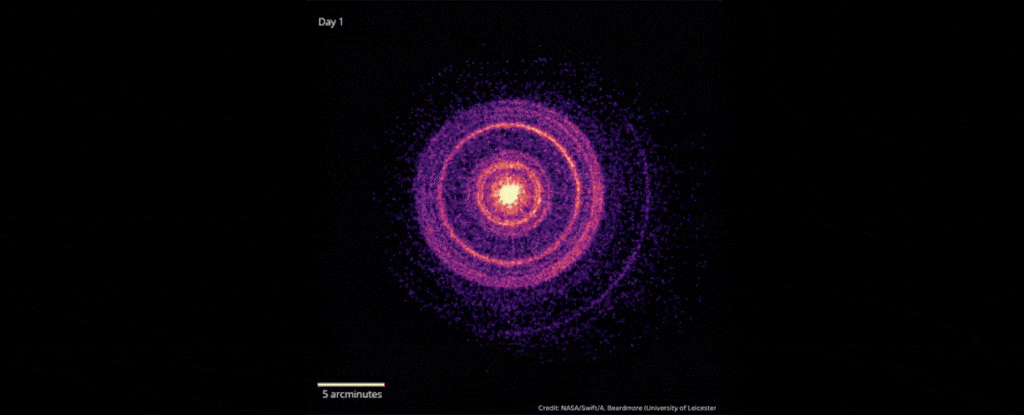In October 2022, scientists detected the explosive death of a star 2.4 billion light-years away that was brighter than any ever recorded.
As the star’s core collapsed down into a black hole, the gamma-ray burst emitted by the star – an event named GRB 221009A – erupted with energies of up to 18 teraelectronvolts. Gamma-ray bursts are already the brightest explosions our Universe can produce; but GRB 221009A was an absolute record-smasher, earning it the moniker “the BOAT” – Brightest Of All Time.
There is, however, something wrong with the picture, according to a team of astrophysicists led by Giorgio Galanti of the National Institute for Astrophysics (INAF) in Italy. Based on cutting-edge models of the Universe, we shouldn’t be able to see photons more powerful than 10 teraelectronvolts in data from the Large High Altitude Air Shower Observatory (LHAASO) that made the detection.
From 2.4 billion light-years away, photons with energies higher than 10 teraelectronvolts should be strongly absorbed by interactions with other highly powerful photons in the faint light between the galaxies, the so-called extragalactic background light.
frameborder=”0″ allow=”accelerometer; autoplay; clipboard-write; encrypted-media; gyroscope; picture-in-picture; web-share” referrerpolicy=”strict-origin-when-cross-origin” allowfullscreen>
So what now? Well, the whole mess just goes away if axion-like particles – one of the leading candidates for the mysterious dark matter that makes up most of the mass in the Universe, as predicted by string theory – enter the mix.
The recent analysis was presented at the 58th Rencontres de Moriond conference in March 2024, and is now available on preprint server arXiv.
“We … show that the issue is solved if we introduce the interaction of photons with axion-like particles (ALPs),” the team writes in their paper.
“ALPs are predicted by String Theory, are among the best candidates for dark matter and can produce spectral and polarization effects on astrophysical sources in the presence of external magnetic fields.
“In particular, for GRB 221009A, photon-axion-like particle oscillations occur within the crossed magnetized media, i.e. the host galaxy, the extragalactic space, the Milky Way, partially reducing the extragalactic background light absorption to a level that explains the LHAASO detection of GRB 221009A and its observed spectrum.”
Dark matter is one of the biggest questions we have about the Universe. Once we’ve taken into account all the normal matter – the stars, gas, black holes, galaxies, rocks, dust, anything we can actually directly detect – there’s way too much gravity left over. Whatever it is that is making that gravity, there’s way more of it than normal matter. Up to around 85 percent of the mass of the Universe is dark matter.
We don’t know what dark matter is, but there are many possible candidates. Axions are a leading contender. These hypothetical particles are thought to behave a bit like neutrinos, in that they don’t interact much with normal matter, which makes them difficult to detect. However, they’re also predicted to behave like dark matter does, so astrophysicists are keen to find evidence of their existence.
frameborder=”0″ allow=”accelerometer; autoplay; clipboard-write; encrypted-media; gyroscope; picture-in-picture; web-share” referrerpolicy=”strict-origin-when-cross-origin” allowfullscreen>
Galanti and his colleagues had previously found evidence of axion-like particles in light from distant blazars – extremely active galaxies that blaze with light. But the brightest gamma-ray explosion ever seen represented a new laboratory for the search for axions.
According to a recent model of the extragalactic background light, high-energy gamma-ray photons traveling across large distances should interact with the background light so strongly that it is unable to reach us. According to the researchers’ calculations, the interactions between photons and axions should make intergalactic space more transparent to high-energy light.
Therefore, the fact that LHAASO detected photons at up to 18 teraelectronvolts could constitute the first indirect detection of axions, the researchers say.
The conclusion is going to require a lot more work before it is confirmed, especially since some other searches have come up with nothing. But we have other places to look; in particular, neutron stars may be pumping out axions at a furious rate.
We’ll nail it yet.
The team’s research is available on arXiv.





